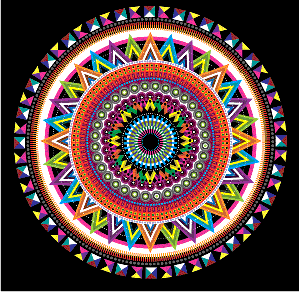
Before knowing what mandalas are used for, we must know that their origin is in India and basically refers to those circular images that start from a central axis, followed by a diverse number of symmetrical figures that are directed towards each other.
The expert Claudio Domínguez, explains that mandalas “from a spiritual point of view are an energetic center of balance and purification that helps transform the environment and the mind of those who meditate with them.”
It is important to know that the word “mandala” comes from the sáncritus (Indo-European language) which translated into Spanish means “sacred circle” or “energy circle”. This word is made up of two parts, each one with its respective meaning, the first part which is Manda means “essence” and La means “concretion”, reason why joining both can be translated as “concretion of essence” and it is said that this occurs when we create a mandala.
Drawing or painting mandalas is a therapy that is being used more and more every day. Its design is free and its meaning will depend on its shapes and colors. Today with digital online tools available worldwide, mandalas have become ever more popular.
Usefulness of Mandalas
Buddhists basically use mandalas as a tool to practice meditation. However, it also has spiritual and healing purposes because it was developed very early in the history of mankind and its design is similar to the structure of the Cosmos, and everything that surrounds us is etched deep in our unconscious.
Mandalas are also perceived from a spiritual point of view as an energy center that helps people who use them have a better balance, purifying their mind and therefore the environment in which they operate.
Today they are also used for therapeutic purposes to lower people’s stress and anxiety levels, by focusing on the mandala and leaving their minds blank, thus driving away the negative thoughts.
7 benefits of mandalas
1. They facilitate balance.
2. They bring peace and serenity.
3. Contemplating them promotes a feeling of tranquility.
4. They help concentration.
5. They facilitate mindfulness.
6. They allow thoughts to be put aside and creativity to flow.
7. The arrangement of the figures transmits a sense of wellbeing.
Meaning of mandalas by their shapes
• Circle: remoteness, but also security, the absolute and true “I”.
• Square: balance and stability.
• Triangle: related to water, transformation and vitality.
• Spiral: healing energies.
• Cross: symbol of decisions and is related to the cardinal points.
• Heart: union, love, happiness.
• Star: related to freedom and spirituality.
• Pentagon: represents the symbols of earth, water and fire, as well as the shape of the human body.
• Hexagon: balance and union of opposites.
• Butterfly: related to transformation, death and self renewal of the soul.
• Labyrinth: confusion, self-reflection and the search for the center of oneself.
Meaning of mandalas by their colors
- White: Purity, illumination.
- Black: Death, sadness, pain, mystery.
- Gray: Wisdom, calmness.
- Green: Nature, hope, freedom.
- Blue: Peace of mind, satisfaction.
- Red: Passion, energy.
- Yellow: Sympathy, the Sun.
- Orange: Courage, energy.
- Rose: Sweetness, femininity, delicacy, altruism.
- Purple: Wisdom, love for others.
- Violet: Inspiration, music.
- Gold: Lucidity, vitality.
- Silver: Well-being, extrasensory capacity.
We believe in the New Earth Shift towards a sustainable lifestyle that creates our own resources and is moving towards self-governance between the people. This will enable people to have more time for themselves and their practice as well as taking care of the planet and learn the traditional ways that once lead the land.
http://ResonanceCR.com/
